| |
|
St
Michael, Hockering
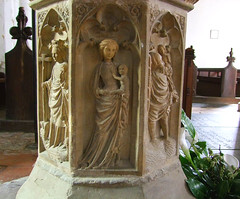 |
|
It
had been the wettest winter in a generation, and
2016 ushered in an unremitting procession of
gloomy, damp weekends. But at last in April there
was a stirring of sunshine as Mother Nature began
to get her finger out, and at last I was able to
return to Norfolk to visit some churches. One of
them was Hockering. I had long looked forward to
coming back here, not least because ten years
previously it had provided me with one of the
more memorable experiences of my journey around
the churches of East Anglia. I returned to the
pleasure of a church stunningly cared for, after
many years of decay. I had witnessed the start of
this TLC some ten years before, when I'd had the
privilege of meeting one of the truly great
Norfolk eccentrics. But sadly, I came back to
discover that he is no longer with us. Back in
2006, I had written: we came to Hockering the
morning after the second exorcism. I couldn't
honestly say that all was calm. It was a day of
sunshine and blizzards, when the light first
dazzled and then submitted to a baffling of
snowflakes as fat as goose feathers. We
church-hopped between the flurries, catching
glimpses and seeking shelter. It was a day to
battle with obscurity, and as I said to Peter
later, it was difficult to know where to start.
|
First of
all, perhaps, there was the screaming skull. Or was it
the cold spots? There were a lot of cold spots,
apparently. But none of that could have happened without
the phone call about the SatNav. And then later there
were the Saints, and there were the extraordinary
Berneys, and there was Catholic treasure from beyond the
great divide. Such a lot to remember. Perhaps it's best
to start at the beginning.
St
Michael, Hockering, is a small-scale work of the early
14th century, vigorously enhanced in the late 15th or
early 16th century, and then, in part, enthusiastically
refurbished by the Victorians in the 1850s, as we shall
see. However, it still retains a lot of its decorated
charm, and the tower is curious because the buttresses
stop short of the later bell stage, making it look like a
small head on broad shoulders. The pretty pinnacles and
battlements help to alleviate this; a crowning, if you
like. The church sits among fields to the west of the
village, and just to the north of the main road from
Norwich to the Midlands, which slices clinically through
the otherwise profoundly rural landscape of central
Norfolk.
We were in Peter's car, heading
across the A47 to St Michael. The keyholder was in the
back. He was in his fifties I suppose, a cheerful man
and, as it would turn out, a kindly man. He was heavily
bearded, with longish hair, as if he had intended to be
on the hippy trail to India, but had ended up in Norfolk
instead. He wore a leather jerkin, rubber waders and a
pearl earring. We were really
grateful that he was giving up his time. He told us about
the lot who'd come yesterday. They'd also been grateful.
They hadn't known, of course, that if they'd waited a
while he'd have been there anyway. He spent hours every
day at the church, because he was verger and sexton and
handyman and cleaner and silver polisher and carpenter
and chief cook and bottlewasher all in one. We hadn't
known that either of course, but it didn't matter.
Yes, that lot yesterday had been
waiting for him when he got there, and he knew straight
away it was an exorcism because there'd been an exorcism
five years ago, and this was just like that. And five
years ago funny things had been happening; you'd take the
candle stocks off the altar and lock them away, and when
you were back out in the nave you'd hear a clatter, and
you'd go back to the vestry and find them rolling around
on the floor. But now they had this woman with them who
could sense evil. She could see it, she could smell
it.
I was trying very hard not to catch
Peter's eye. I feared it might break the spell. I have
now visited nearly 1200 churches in Norfolk and Suffolk,
but this was gold dust. I had never heard anything like
this before. My mind rolled, and I felt a thrill of
excitement.
Fifteen
minutes earlier, when we'd first arrived at the church,
I'd actually been feeling a little low. We'd just been
subjected to the flat-lining pulse of Honingham St
Andrew, and so to find another locked church was
depressing, even though it had a keyholder notice.
Through the magic of the OS street atlas of Norfolk we
found the house where the keyholder lived; but when I
knocked on the door, there was no answer. I waited and
waited while Peter turned the car around. The house
wasn't far from the church, but it was on the
far side of the A47, which no pedestrian crosses safely.
And I waited, and I thought to myself, I wonder if
there's a key hanging up somewhere? Because some
keyholders keep the key hanging up outside for other
parishioners to use. And just as I thought I might look
for it, the door opened.
Within
moments, I knew that I was in the presence of one of
Norfolk's great eccentrics, which is saying something,
because in this day and age the county may well have
cornered the market, at least as far as England goes. And before we left Hockering, which would be
fully two hours in the future, I would know that, thanks
to this friendly, candid man, if any church in Norfolk is
to survive the next quarter of a century it will be
Hockering.
He invited
us in to his house while he looked for the key, but what
had surprised him was that we had found his house at all.
Because that lot yesterday had phoned him up and said
they couldn't find his street, and asked him for the post
code of the church so they could put it in the SatNav,
and then they could let the SatNav direct their car to
the church, and he laughed and said there was no need,
he'd meet them there, and the church was easy to find
because it was the big thing that looked like a church.
He'd got to the church, and they
were waiting. Three clergyman and a woman who saw things
other people couldn't see, felt things they couldn't
feel. And she'd wandered around, poking in corners, and
she found all these cold spots. There'd been one in the
porch, and one by the font, and several in the vestry.
Worst of all, up in the west gallery she'd sensed a
screaming skull. That was the motherlode as far as evil
was concerned, and the exorcism team sprang into action.
I made up my mind that, more than
anything, I wanted to go up into the west gallery and
sense the screaming skull. We got to the churchyard, but
the porch was out of commission and cordoned off. It
wasn't clear if this was due to falling masonry or
demonic possession*. Instead, we were let into the chancel,
through the Priest's door.
| |
|
Hockering chancel is an
opulent 19th century refurbishment quite out of
character with the rest of the church. The
chancel arch and its matching stone reredos in
particular are textbook examples of the
international mid-19th century Early English
style, familiar to church explorers from
Vancouver to Calcutta and beyond. The arch in
particular must have cost a fortune. Fortunately,
the Victorians used the old bench ends for the
stalls, or perhaps they had simply run out of
money by then. Certainly, the 1890s rood screen
does not match the stonework for quality. However, west of the chancel arch is
a small nave with a north aisle, and it is full
of local character, with an air of the centuries
conspiring, through a mixture of care and
neglect, to leave us something unique. And best
of all is Hockering's wonderful font. It sits
beneath the George III royal arms on the front of
the west gallery, and it soon distracted me from
searching for skulls. The bowl is Victorian and
perfunctory; the shaft is medieval, and
wonderful.
|
It depicts
eight Saints, standing in niches. Their heads were
whacked off by 16th century protestants, and have since
been replaced, but they are in the main in good
condition, beautifully clear and identifiable. They
include St Michael, St Andrew, St Margaret, St Catherine,
St Christopher and the Blessed Virgin and child.
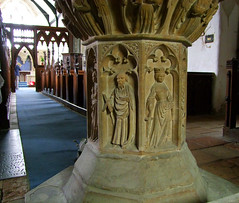   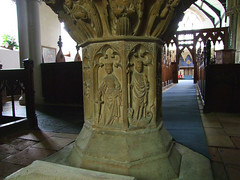
It has to
be said that the interior of St Michael is slightly
ramshackle, though pleasantly so**. It is, however,
very clean. This is because the keyholder has been
systematically working his way through the building,
cleaning and sealing dusty surfaces, polishing the wood
and scraping the muck off the stone. So far, it has taken
him almost two years of daily work, and he still isn't
quite finished. Now, England is full of people who love
their parish church, but it is rare to meet someone who
so wholeheartedly backs up this love with the sheer sweat
of his brow, and I admired what he was doing here
immensely.
The
majority of the benches in the nave are late medieval,
with simple, carved poppyheads. At the front, a box pew
bears the arms of the Berney family, who are one of the
long-established stars in the firmament of Norfolk
landowners. By the 13th and 14th centuries they were busy
organising the peasantry in these parts, as well as
elsewhere in Norfolk. Incredibly, they still live at
Hockering Hall, the current incarnation of which is a
modernist building of the 1950s.
And St
Michael, which is by no means one of Norfolk's more
significant churches, is still their church, and
their patronage still falls heavily here. The current
family attend the church every Sunday, and they form a
significant proportion of the tiny congregation. I
thought that this was wonderful, like something out of an
Evelyn Waugh novel. Apparently, it is still the job of
the churchwarden to make sure that nobody else sits in
the Berney pew. A few months back, someone they hadn't
seen before arrived early for the evening service, and
sat down in it. There was a collective sharp intake of
breath from the half dozen or so locals sitting behind,
and the stranger had to be turfed out and rehoused in the
cheaper seats.
Mortlock,
visiting in the early 1980s, said that there was an air
here of a church not being forgotten, but not cherished
either. He'd probably say the same today, but I think
this is simply because of the junkshop atmosphere of a
quirky church with much of interest and more than a
little rustic character**.
Typical of
the quirkiness is the brass to Humphrey Smallpece,it
reads Milleno, Quingenteno Anno ter quique deno et
nono Domini, dum Rex Henricus et annum primum post deno
tres regni Octavus agebat, Hic evit Humpfridus Smallpece
aestate sepultus.

This
translates as 'In the summer of the year 1539, as King
Henry VIII began the 31st year of his reign, Humphrey
Smallpece died, and was buried here'. This is curious,
because it means that here we have an inscription from
the very earliest stages of the English Reformation, when
England was still a Catholic country, and yet it is
entirely secular.
At last,
we went up into the gallery. It has been built into the
splay of the west window, and is approached via the tower
stairs, but it is too rickety to be used by the public
anymore***. It is cluttered
with equipment - a lawnmower, planters, and old books
under a carpet of dust. No screaming skulls, though. The
keyholder could see in our faces that we thought it
untidy, and he laughed. "This is what the rest of
the church used to be like", he observed.
Finally,
something genuinely extraordinary. Hockering parish
possesses some 16th century plate, including an exquisite
silver paten with the head of Christ in the centre. This
can be dated accurately from a will bequest of 1520.
There is also a cup of 1570, post-Reformation of course,
bearing the inscription HOKRYNG TOWN. These are now kept
in safe storage in Norwich, not at the church, but they
had recently been returned to the parish from an
exhibition, and were due to go back to Norwich later that
afternoon. Our friendly keyholder produced them with a
flourish for us to look at and photograph - tremendous
treasures from a world ago, now rarely exposed to the
light of day.
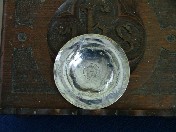 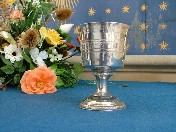 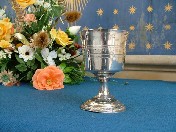
So, that
was Hockering. We took the kindly keyholder home, and
headed on to the relative sanity of the Wensum group of
parishes to the north. As we drove, I was thinking about
the Berney pew, Noel Coward's chorus running through my
head:
The
Stately Church of England, how beautiful it stands,
To prove the upper classes have still the upper hand
and
wondered to myself if, when I came to write about
Hockering, I should mention the exorcists. The thing is,
I get an increasing number of crank e-mails from people
claiming to represent organisations with wacky names like
the Suffolk Paranormal Society, and the North Essex Ghost
Hunters. They ask me if I know of any haunted churches
for them to investigate. My answer, in the days when I
still bothered to answer them, was no, of course I don't.
How on earth could a functioning, welcoming, prayerful
church possibly be haunted? I fear they may now and try
and get their talons into Hockering, and it will be
partly my fault. All I can say is that there are now no
ghosts at Hockering, and I don't believe that there ever
were.
* The
porch has since been beautifully restored.
** This is no longer the case, the church is immaculate
inside.
*** The gallery is no longer accessible.
Simon Knott, March 2006, revised and
updated May 2016
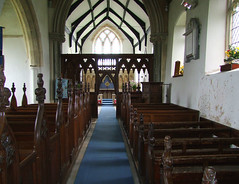 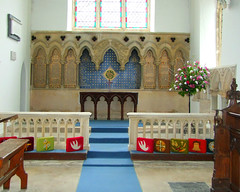 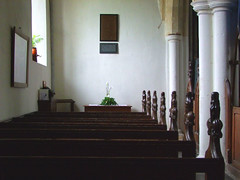
  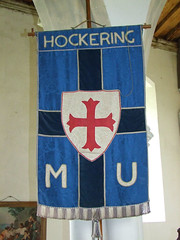  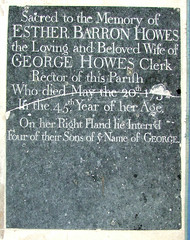
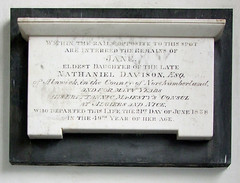 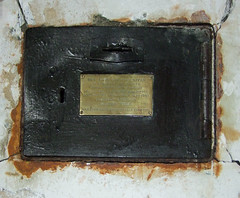 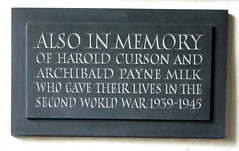
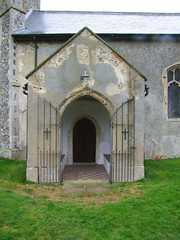
Amazon commission helps cover the running
costs of this site
|
|
|
